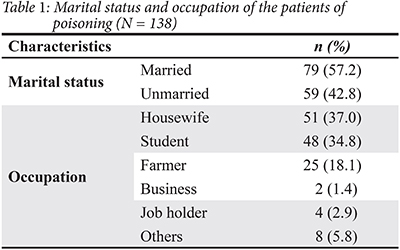Pattern, Management, and Outcome of Poisoning in a Tertiary Care Hospital
Keywords:
antidote, insecticide, organophosphorus, poison, suicideAbstract
Introduction: Poisoning is a significant global public health problem. The appropriate management of poisoning at emergency needs accurate assessment and immediate treatment. The immense chance for better outcomes occurs with early diagnosis and treatment. This study was conducted to assess pattern, management, and outcome of poisoning in tertiary care hospital.
Methods: An observational cross-sectional study was conducted in which records of patients with a diagnosis of poisoning over a period of four years were reviewed.
Results: A total of 138 patients were included in the study. A majority (63%) of them were females. Most (67.4%) were managed by general or supportive measure only. Gastric lavage was done in 60% of total patients while 52.9% patients received activated charcoal. Pralidoxime and atropine was received by 51.1% of patients treated with specific antidote. All the antidotes were administered through intravenous route. Regarding outcome, 89.9% were completely recovered. Suicidal poisoning was significantly higher in married as compared to unmarried patients (p = 0.029). Similarly, there was a significant relationship between occupation of the patients and manner of poisoning (p = 0.003). Outcome of treatment had a significant association with the manner of poisoning (p < 0.001). Further analysis revealed that the patients who expired in the hospital were more likely to ingest poison accidentally.
Conclusion: Suicidal poisoning is common and females are more susceptible. Insecticide and rodenticide are the commonly ingested poisons. Treatment outcome of poisoning cases is generally favorable.
Downloads

Downloads
Published
How to Cite
Issue
Section
License
The Journal of Lumbini Medical College (JLMC) publishes open access articles under the terms of the Creative Commons Attribution(CC BY) License which permits use, distribution and reproduction in any medium, provided the original work is properly cited.JLMC requires an exclusive licence allowing to publish the article in print and online.
The corresponding author should read and agree to the following statement before submission of the manuscript for publication,
License agreement
In submitting an article to Journal of Lumbini Medical College (JLMC) I certify that:
- I am authorized by my co-authors to enter into these arrangements.
- I warrant, on behalf of myself and my co-authors, that:
- the article is original, has not been formally published in any other peer-reviewed journal, is not under consideration by any other journal and does not infringe any existing copyright or any other third party rights;
- I am/we are the sole author(s) of the article and have full authority to enter into this agreement and in granting rights to JLMC are not in breach of any other obligation;
- the article contains nothing that is unlawful, libellous, or which would, if published, constitute a breach of contract or of confidence or of commitment given to secrecy;
- I/we have taken due care to ensure the integrity of the article. To my/our - and currently accepted scientific - knowledge all statements contained in it purporting to be facts are true and any formula or instruction contained in the article will not, if followed accurately, cause any injury, illness or damage to the user.
- I, and all co-authors, agree that the article, if editorially accepted for publication, shall be licensed under the Creative Commons Attribution License 4.0. If the law requires that the article be published in the public domain, I/we will notify JLMC at the time of submission, and in such cases the article shall be released under the Creative Commons 1.0 Public Domain Dedication waiver. For the avoidance of doubt it is stated that sections 1 and 2 of this license agreement shall apply and prevail regardless of whether the article is published under Creative Commons Attribution License 4.0 or the Creative Commons 1.0 Public Domain Dedication waiver.
- I, and all co-authors, agree that, if the article is editorially accepted for publication in JLMC, data included in the article shall be made available under the Creative Commons 1.0 Public Domain Dedication waiver, unless otherwise stated. For the avoidance of doubt it is stated that sections 1, 2, and 3 of this license agreement shall apply and prevail.
Please visit Creative Commons web page for details of the terms.



